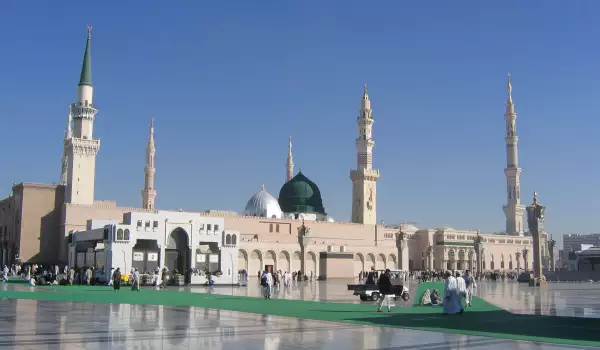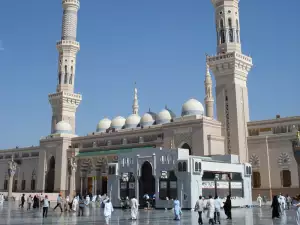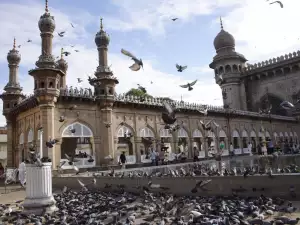Al-Masjid an-Nabawi

Al-Masjid an-Nabawi or the Mosque of the Prophet is the second most important shrine for Muslims worldwide. Immediately after the Masjid al-Haram, Al-Masjid an-Nabawi, built in Medina, is one of the most important symbols of Islam in Saudi Arabia and one of the largest mosques in the world. The huge religious importance of the temple comes from the fact that here the Prophet Mohammed died, whose remains have survived to today in Al-Masjid an-Nabawi.
The original mosque was built by Mohammed near the house where he settled after his arrival from Mecca in Medina in 622. This year is the foundation of the Islamic calendar, and is denoted by the term Hijrah and is considered the source of Islamic chronology.
The prototype of Al-Masjid an-Nabawi is an open building with a raised platform for reading the Quran. The temple had a rectangular shape with dimensions 30 to 35 meters and was built with palm trunks and mud walls, beyond which was entered through three doors: the southern Bab Rahmah (Gate of Mercy), Western Bab Jibril (Gabriel Gate) and Bab al- Nisa '(Women's neck) to the east.
The home of Mohammed and his family is next to the mosque. Subsequently, almost all of the original structure was destroyed, including the rooms of the wives of the Prophet, with the exception of Aisha's room, where Mohammed is buried, along with two of his successors - Abu Bakr (632-634) and Umar (634-644).
Al-Masjid an-Nabawi was rebuilt between 705 and 709 by the Caliph Al-Walid I of the dynasty Umayyad, at the place which was formerly home of the prophet. According to the history of the Caliph al-Walid, he required that newly built mosque be measuring two hundred two hundred cubits, and has a square shape.
This practice was not achieved because the corners of the temple were not quite right and the north wall was a little shorter than the south. These small variations were invisible to the eye. The lord entrusted to Greek architects to build the mosque of the Prophet and left hanging the question of whether the inaccuracies are inadvertent error or intentional variation, which is typical to all Byzantine buildings.

Al-Masjid an-Nabawi had a yard which occupies the greater part of the entire area. Covered areas already represent the main part of the area and the yard is hidden inside four covered rectangles. The interior is in practice part of the "House of the Prophet", because the rough shelters of palm trunks are not a wall, but a shady part of the yard.
The prayer hall of the mosque of the Prophet forms pure unity with its magnificent ceiling, worn by five rows of columns parallel to the Qiblah wall with its mihrab (niche decorated showing Qiblah direction for prayer) and minbar (raised area for sermons). The covered northern prayer hall is designed for women, which is accessed through a special door called "Door for women."
A feature of the Al-Masjid an-Nabawi is the high green dome, known as the Dome of the Prophet and marks the place where Mohammed is buried. 4 towers were built, which are prototypes of today's minarets. The mihrab, or niche, became a direction of prayer, pointing to Mecca, where the sacred Kaaba stone is, is located in the left half of the new mosque. So, the mihrab of Al-Masjid an-Nabawi is actually right in the center of the former room of the Prophet and was designed to determine the exact place where the Prophet stood. The rich decorations are remarkable.
In the course of history mosque Al-Masjid an-Nabawi serves as a court, community center and religious school. In 1909, it became the first in the Arabian Peninsula, to have electric lighting. The heart of the temple has a little room ar-Rawdah an-Nabawiyah, marked by the grave of Mohammed. Pilgrims in the Al-Masjid an-Nabawi try their best to get to this place because it is believed that prayers uttered here are always heard. In 1955 the second most sacred shrine of the Muslims in Medina had been greatly expanded. The entire mosque is decorated with marble decorations and is fully air-conditioned.















